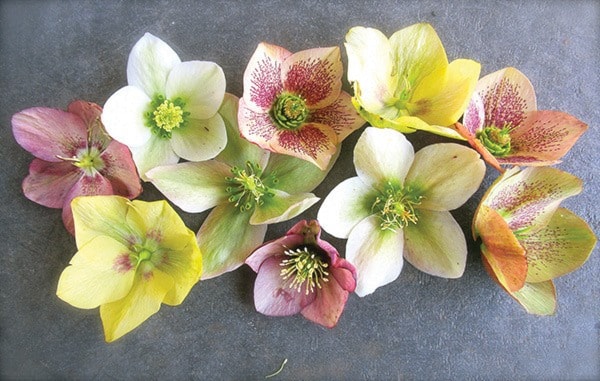Your hellebores cost you a fortune, I know. Twenty dollars a piece, most likely. Harvest them? They rarely put up more than four or five flowering stalks, the younger ones even less, and they take years to mature. Harvest what? The flowers. Not only will this give you a fine arrangement, it’s of some benefit to the plant.
But before we get to the harvest: Hellebores are a large group of winter-flowering perennials. Helleborus spp. include the Christmas rose, the Lenten rose and its numerous hybrids and other species. All bloom early, even in snow. By March, their flowering stalks stand about a foot above the soil. The range of new hybrids astounds – flower colours range from apricot to chartreuse to white to pink, plum, burgundy and black.
Many varieties have flowers that shift colours as they age. And foliage similarly is diverse: silver, silver-veined, matte, glossy, jade, emerald, finely cut or broad-leaved. Hellebores thrive in darkened corners, shady beds and woodland settings. Deer-resistant, drought-tolerant, architectural and evergreen – hellebores are a perfect plant for our region.
And now, with this season’s leaves just rising from the earth, it is the perfect time for pruning the flowers, so that the plant can direct its energy into leaf growth. (If you are hoping the plant might propagate itself, leave your flowers to run to seed. But remember, many are sterile and even if they do make babies, hellebores still take years to bloom, which in part explains their high price.) In any case, most gardeners trim off the spent flowers in late spring once the plant’s new leaves have emerged. I suggest bringing the flowers indoors for a closer look before sending them to the compost.
The trick to using hellebores as a cut flower is conditioning, which in this case means dipping the cut stems into boiling water. A little time consuming, but I guarantee that if you follow these steps you can enjoy hellebores in the house for days without wilting.
First, put a pot of water or a kettle on to boil. (Hellebores are poisonous, so I use an old pot.) Have your snips and a wide-mouthed jar of cold water at the ready. When the water boils, set off outside and cut your chosen stems. Back in the house, nip another inch off the stems and immediately plunge them at an angle into the hot water for 30 seconds, being careful not to steam the blossoms. Then drop them into the jar of cold water. Flower farmers believe that older, ripened flowers (those that have dropped their stamens) last longer in the vase. And speaking of vases: plan ahead so you can cut your stems to length before the hot water treatment. As with any cut flower, strip off any leaves that might sit below the water line.
If you can’t be bothered with conditioning, you can also float individual hellebore blossoms in a bowl. For a plant that often nods shyly alongside a path, you’ll be amazed at the singularity of their beauty.
